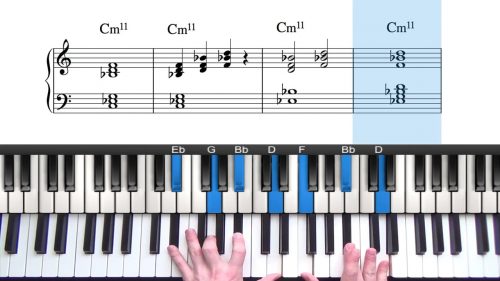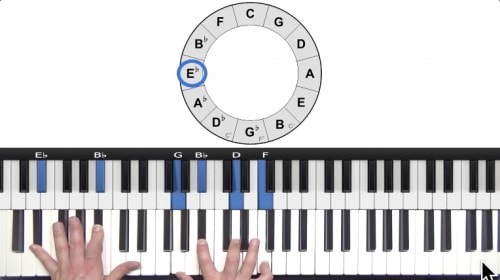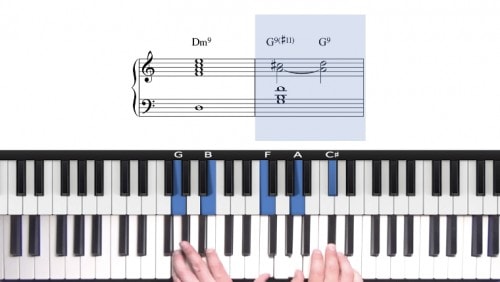What Are Upper Structure Triads?
Welcome to this tutorial on upper structure triads. Upper structure triads are complex altered dominant chord voicings that are widely used in solo jazz piano performance.
Why “Upper Structure” Triad
You may be wondering why is this type of voicing is called an upper structure triad? Well that’s because there are 2 parts to the chord, the upper structure and the lower structure.
The Lower Structure
The lower structure is the vanilla dominant chord voicing, so for C7, we could play root, 3rd and b7, and if you have a wide stretch we can play those notes like this, we could play just the root and b7, we could play just the 3rd and 7th, and we can also invert that 3rd and 7th. Each of these creates a different LH texture.
The Upper Structure
So what about the upper structure? Well the upper structure is played in our right hand, and the cool thing about these voicings is that we only need to use major triads to construct the 4 most useful and versatile upper structure triads. We must be comfortable with the major triads in all 12 keys & also the inversions.
Why Split The Chord Into 2 Parts?
That’s a very good question! The answer is that it gives us simple formulas to memorise complex altered dominant chord voicings. For example if we want to play a C13#11 chord, we just think D major triad over C7 and with practice that process becomes very quick to visualise until it is an almost subconscious process.
The other key benefit is that by visualising the upper and lower structure as 2 separate entities, we can easily maneuverer and manipulate the shapes in each hand to create many different textures using the same chord colour.
The 4 Common Upper Structures
Download the upper structure cheat sheet which contains the 4 most useful upper structure formulas.
-
The first is US2 which is a major triad built from the 2 or 9. This gives us a 13#11 sound, as our right hand is outlining the scale degrees 9, #11, and 13.
-
Next we have US#4 or #11 which is a major triad built from the #11. This gives us a b9/#11, as our right hand triad outlines #11, b7, and b9.
-
Next we have US#5 which is a major triad built off the #5. This gives us a #5#9 sound, also known as alt. The triad contains the #5, root & #9 and it has a very tense sound.
-
Finally we have US6 or 13 which is a major triad built of the 6 or 13. This gives u a 13b9 sound. Our right hand contains the tones 13, b9, and 3.
So that’s the 4 most common upper structures. In our altered harmony course you can find practice drills and exercises to
Let’s now finish by applying these voicings to 3 jazz standards and use the upper structure cheat sheet as an aid to help us find suitable upper structure voicings for dominant chords in our favourite tunes.
Lesson Downloads
-
Upper Structure Triad Cheat Sheet File Type: pdf
-
Jazz Voicings Cheat Sheet File Type: pdf
-
Upper Structure Triad Lesson Notation File Type: pdf
Practice Tips
-
First learn the options available for the left hand. Experiment with the root, 3rd, 7th, and the different inversions.
-
To play these voicings effectively we must be comfortable with the 12 major triads and their inversions.
-
Take an upper structure demonstrated in the key of C and transpose this around the other keys.
-
Experiment with upper structure inversions and doubling the notes at the top and bottom of the triad to create a bigger sound.
-
Check out the altered harmony practice series where we learn and memorise these voicings in all 12 keys.








Hello. Either I’m crazy, or your music sheet has the wrong notes for C13(b9) on your upper structure triads worksheet with notations and examples. I’m trying to learn this and it took me a few times of watching your hands to finally figure it out. Roy.
Hi Roy,
No you’re not crazy… thanks for spotting that!
Apologies for the 2 typos. I have fixed the mistake in both the lesson notation, and the PDF download.
Sometimes these errors creep into the lessons and so if ever in doubt follow what is being played and shown on the keyboards.
Also it’s very important to learn the 4 formulas on the Upper Structure Cheat Sheet. Learning those 4 formulas is the key to internalising the information so that we can quickly and easily find the voicing shapes in all 12 keys.
Here to help if you have any further questions.
Cheers,
Hayden
I didn’t quite get how you chose an upper structure based on the tune. Is there a transcript of the lesson?
Hey Sherry 👋
We choose upper structures based on the melody note.
I recommend to download the “Upper Structure Triad Cheat Sheet” which is listed in the Downloads section of the page.
Whenever we come across a dominant chord on a lead sheet, we first identify the scale degree of the melody note in relation to the underlying chord. Next we match this scale degree to one of the scale degrees in the right column of the cheat sheet. The final step is to find the appropriate inversion of the triad.
This is a slow process to start with, but with time and practice, the formulas become 2nd nature and your hands will gravitate towards suitable voicings.
I recommend to print out the “Upper Structure Triad Cheat Sheet” and stick it on or near your piano for quick and easy reference.
I have covered Upper Structure Triads extensively on the website, using the search box you can find many theory lessons and also jazz standard lessons where we cover and apply this topic, please see here:
pianogroove.com/?s=upper+structures
Spend some time to work through the lessons listed in the search results – both the theory studies and the jazz standard lessons – and you will become much more comfortable and confident with Upper Structure Triads and altered jazz chords.
Also, here is our dedicated course on “USTs & Altered Harmony” – pianogroove.com/jazz-piano-lessons/altered-harmony-upper-structure-triads/
Please let me know if I can be of further assistance and enjoy the lessons.
Talk soon,
Hayden
Great lesson thanks